Can Sugar Improve Your Cannabis Plant Growth?
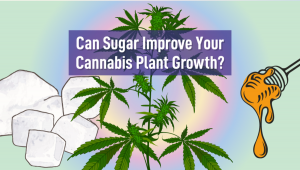
- 1. Cannabis and sugar water: why should it work at all?
- 2. Defoliation as a form of sugar management
- 3. Using extra sugar for your cannabis grow
- 3. a. Monosaccharides vs polysaccharides
- 3. b. Molasses
- 3. c. Honey
- 3. d. Sugar water
- 3. e. Carb-containing supplements
- 4. How to measure sugar content in cannabis plants
- 5. Using sugar to boost cannabis growth faqs
- 6. Bottom line: tread lightly!
Feeding cannabis plants sugar water, molasses, honey, or other sweets is a controversial and poorly researched subject. Some growers swear by it, others say it’s useless at best and harmful at worst. Many plant food manufacturers add sugar and other carbohydrates to their ‘miracle’ products. So, who is right and who’s wrong? We suggest that you should experiment with giving autoflower seeds or feminized seeds sugar after you have mastered all the other, more important and impactful, aspects of cannabis cultivation. Also, take a minute to understand how cannabis plants produce sugar naturally and how you can influence this process.
1. Cannabis and Sugar Water: Why Should it Work at All?
In cannabis and any other green plants, sugar plays a pivotal role because it’s a convenient way to store, transport, and use up the energy produced through photosynthesis. The form of sugar that plants synthesize is called glucose. Plants make glucose using chlorophyll in their leaves. They take molecules of water and CO2, apply the energy of the sunlight to them, and produce glucose (plus oxygen as a byproduct).
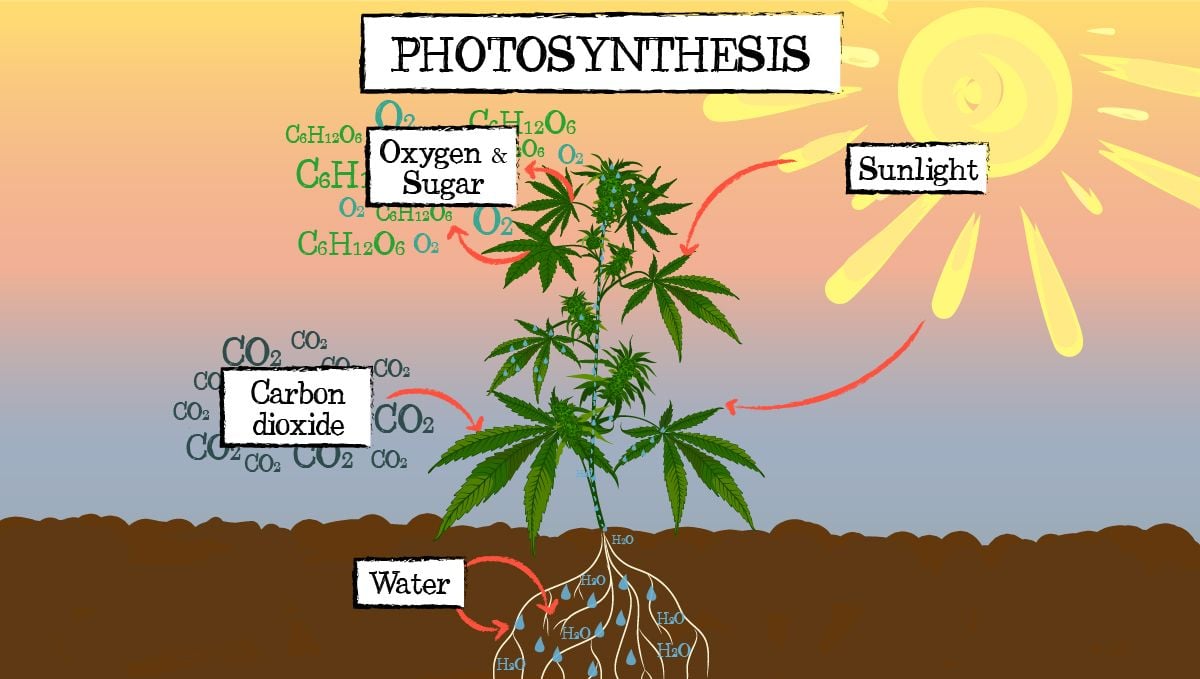
After that, glucose can be converted back to energy—in the process of respiration—or used to produce everything else a plant needs:
- cellulose, to build cell walls and add strength and structure to plant tissues,
- starch, to store energy long-term,
- amino acids, building blocks for proteins,
- lipids, fats and oils needed in seeds.
Thus, sugar is one of the primary agents in plants’ internal chemistry, and this inevitably raises a question: should we only try to influence the natural production of sugar or maybe start feeding cannabis plants sugar water? Let’s start with the first option.
2. Defoliation as a Form of Sugar Management
A weed plant is perfectly able to produce all the sugar it needs. At least when it’s healthy. All you need is to create a good environment for it, water it, feed it, provide it with fresh air, etc. We know of only one hack to influence sugar production, and it’s called defoliation. Defoliation, as well as trimming and pruning, is not only a way to give the canopy the shape you want. It can also beneficially influence the transport and storage of sugar. Yes, young leaves do produce sugar (and you shouldn’t pluck them unless absolutely necessary), but then this precious sugar is transported to older leaves for storage.
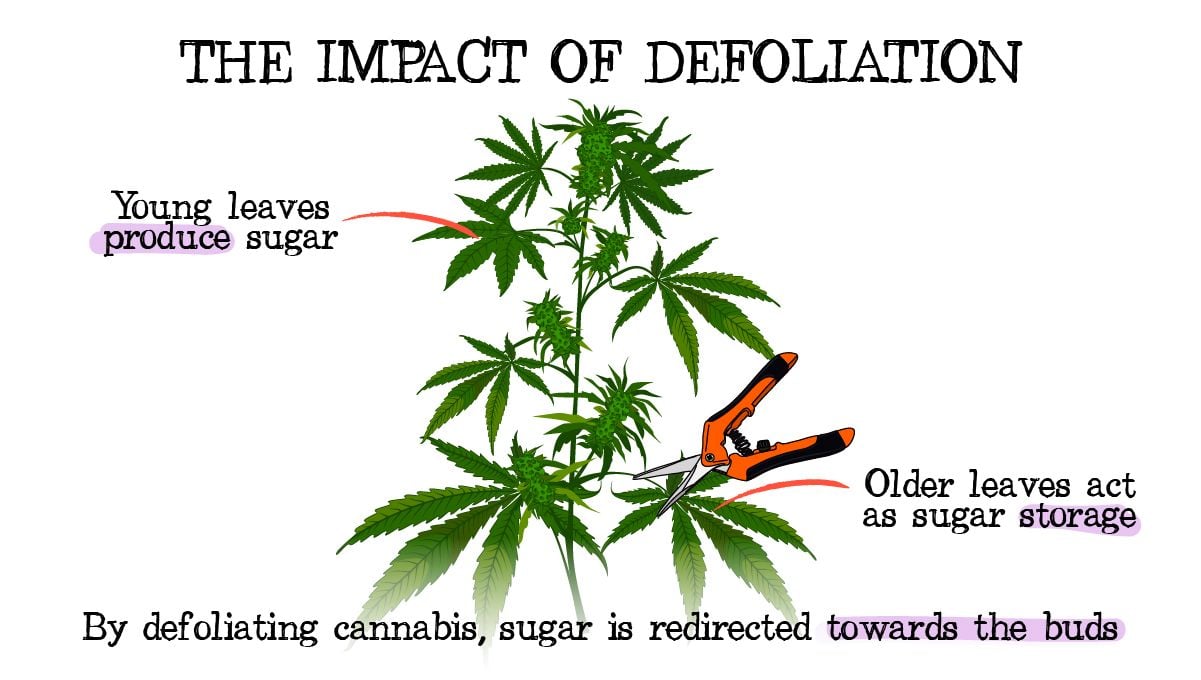
You’d be much better off if you can redirect this natural flow to buds instead of older leaves. And defoliating these leaves is a good way to do it. Growers have been successfully defoliating photoperiod genetics for decades now. Recent progress has also led to the creation of autoflower strains that are strong enough to benefit from defoliation, too. So, if you’re an autoflower grower, feel free to experiment.
3. Using Extra Sugar for Your Cannabis Grow
The idea isn’t exactly new although there is very little research confirming the efficacy of sugar for different crops. For cannabis, research is non-existent. It’s an established fact that plants transport some of the glucose they produce into the root zone and then release it into the medium. It is a godsend to beneficial bacteria and other weed’s little helpers living in the rhizosphere. They start feeding on this glucose, multiply, and work on breaking down complex organic nutrients and making them available to the plant.
One study found out that roots can actually uptake some of that glucose from the medium and back into the plant. And this is good news because it means that roots can probably absorb extra sugar too. Okay, but what kind of sugar?
Monosaccharides vs Polysaccharides
Glucose is a simple sugar, aka monosaccharide. And those who oppose the idea of giving cannabis plants sugar point to the fact that we, people, consume mostly polysaccharides. Or, to be more exact, sucrose. Sucrose is what table sugar consists of. It’s a much more complex chemical, and we simply don’t know for sure if cannabis can process it. Or to what extent. So, all the forms of table sugar—be it cane sugar, or powdered sugar, or any other kind—aren’t the same as glucose, and you should treat them with caution. But what about other sweet products that contain monosaccharides?
Molasses
If you have any experience growing cannabis, you’ve probably used molasses or at least heard of it. There are many products on the market called something like blackstrap molasses or unsulphured molasses. All these names mean the same thing — a byproduct of cane sugar processing, containing a mix of mono- and polysaccharides.
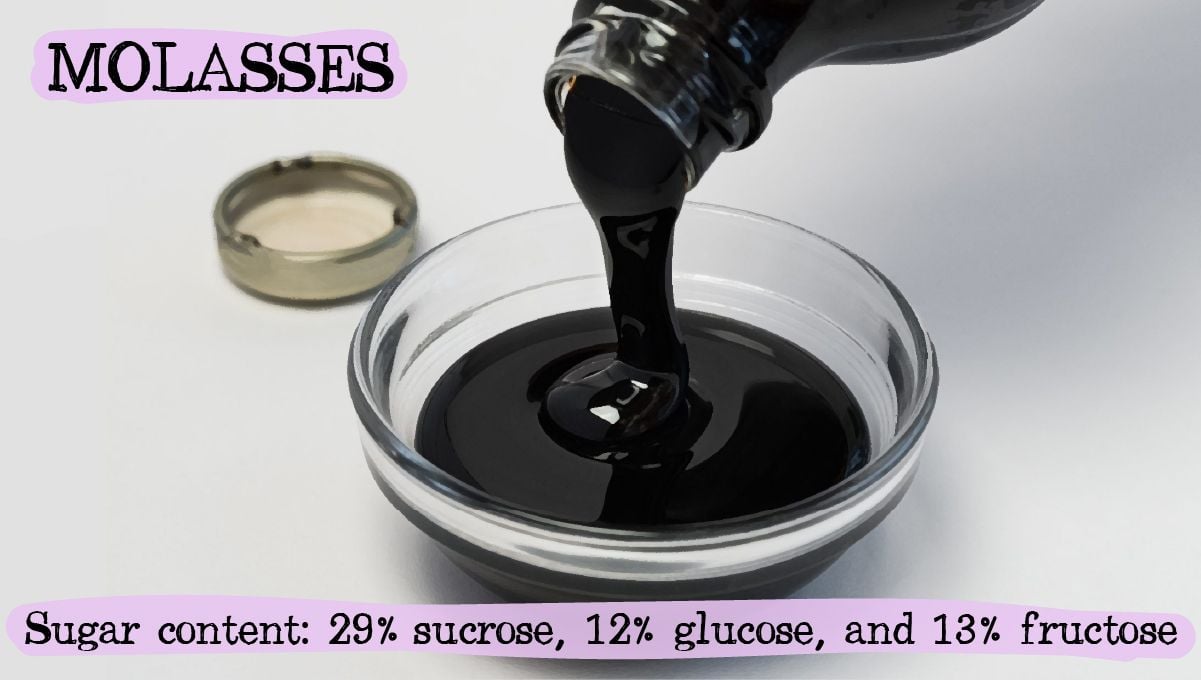
The exact ratio of sugars in molasses may differ, but here’s an example: 29% sucrose, 12% glucose, and 13% fructose plus water. The presence of a good amount of such monosaccharides as glucose and fructose makes molasses a much more promising product for cannabis cultivation. According to one study, using organic fertilizers and molasses at the same time significantly improved yields of spinach. Molasses without extra fertilizers had no effect.
People use molasses in organic grows because its sugars feed the beneficial bacteria living in the soil. Some of them probably find their way into the plant too (if it’s glucose-deficient). Most often, growers add molasses to their feeding solution in flower. Some use them to reduce the shock of a transplant.
There is an interesting example of sugar manipulation through both the defoliation and the use of molasses. In the case of extreme defoliation called schwazzing, it’s recommended to give a plant a healthy dose of molasses because it has lost most of its foliage and can produce too little sugar itself.
As for the dosages, there are a lot of different recommendations experienced growers give:
- 4–5 ml per liter,
- 1–2 tbsp (15–30 ml) per gallon,
- 2 tbsp (30 ml) per 5 liters.
As always, we recommend going easy. It’s the safest way when you experiment on a living thing.
Honey
Honey—like, in fact, any other form of sugar—has antifungal and antibacterial properties. One can use it to dress a wound, and likewise, you can apply honey to your cuttings if you’re afraid they can be attacked by harmful microbes. And while concentrated natural honey kills microbes, a very weak solution of honey in water can actually feed little critters living in the root zone. So quite a few organic growers add something like a teaspoon of honey to a gallon (3.8 liters) of water and believe this will make their buds fatter and sweeter.
Sugar Water
Those who heard of using molasses in cannabis cultivation start to wonder if they can use brown sugar as well. After all, brown sugar contains not only sucrose but also some molasses. If you grow your marijuana organically and want to give a feast to the bacteria living in the soil, you can try and give them just a bit of sugar water. But are you sure you won’t overdo this? Remember, that too much sugar stops feeding and starts killing. Not to mention the possible harm to the roots themselves.
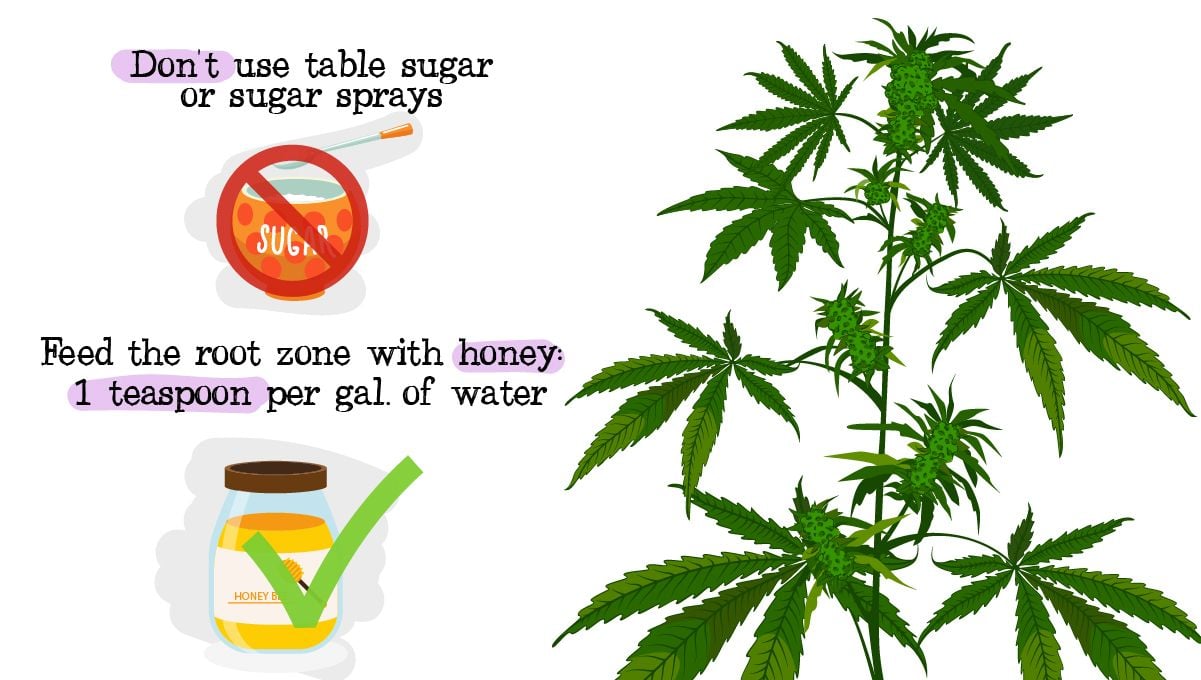
So, we recommend not to mess around with any kind of table sugar. The same goes for sugar sprays for your cannabis — its leaves will hardly benefit from such a shower.
Carb-Containing Supplements
Cannabis enthusiasts love the sweet aroma of ripe buds and enjoy their sugary looks so much that any nutrient with a sweet-sounding name is instantly appealing. We can’t help but think that its carbo-load will somehow find its way into the finished product. And probably, it will. Anyway, some reviews say these amendments really make a difference. We’ll list here just a few of them:
|
FloraNectar Fruit-n-Fusion (General Hydroponics) |
Contains molasses, malt syrup, and cane sugar. |
|---|---|
|
(General Hydroponics) |
A mix of minerals and molasses to make buds sweeter. |
|
(Advanced Nutrients) |
Contains both simple and complex carbohydrates which “translate directly to floral sugars”. |
|
(Advanced Nutrients) |
Cranberry and grape extracts to instantly improve the scent of flowering cannabis. |
|
(Botanicare) |
An undisclosed formula provides additional aromas and taste. |
4. How to Measure Sugar Content in Cannabis Plants
The amount of sugar present in a cannabis plant is usually measured by its Brix levels, which measure the angle at which light moves through the juices inside cannabis plants. This technique is not sued with all plants but with cannabis plants, measuring Brix levels is an effective way to measure the amount of sugar inside a plant. This is done by measuring the amount of solids in the cannabis plant’s sap, which means that the higher the Brix levels found, the healthier the plant is.
Brix levels can be measured using small devices called refractometers (aka a refractometer tool). Ideally, you should use a tool designed for Brix levels up to 32% and should automatically account for the temperature. So the first step to measure Brix levels (or sugars in a cannabis plant) is to calibrate the refractometer tool with distilled water, the tool should read 0% and this is the confirmation that the tool is working correctly and it’s ready to measure Brix levels. This device measures a plant’s juices so you should pick a small leaf and crush it to bring out the juices, this juice can then be tested with the refractometer; In order to get an accurate reading, make sure the juice is pure and not contaminated with impurities such as substrate or tiny pieces of green matter.
An average of 22% is considered to be the optimal sugar content for cannabis plants but a minimum of 12% is considered necessary for healthy plant growth. If the plant’s Brix levels are below 12% then you want to add more sugar to increase the sugar concentration of your crop. If you do not have access, the means to invest in a refractometer for cannabis plants or just cannot find one, a cannabis plant can give you an indication of its sugar contents and energy through their appearance as cannabis plants with high Brix levels will develop a healthy, shiny and waxy-like appearance.
5. Using Sugar to Boost Cannabis Growth FAQs
While the science behind sugar supplements for boosting cannabis growth is still in need of further research, there are a bunch of established cultivators who do swear by the practice - and this particulary goes for organic growers. We thought we would sit down with one and shoot off the most frequently asked questions regarding the practice, and see what he had to say. He asked for us to keep his identity secure, as he lives in a non-recreational legal area.
Hey, welcome to Fast Buds! How long have you been growing organically, and on what scale?
Thanks so much for having me! I have been growing in and off since I was a teenager, but really got into it about 10 years ago when I was 24. I have since gone from being my one and only hobby to it now being my full-time job. In terms of organic cannabis cultivation, that's actually how I started. I then moved into hydro and commercial growing, before deciding to bite the bullet and make the switch back to full organic about 4 years ago.
What types of sugar do you use to supplement your grows?
I use a variety of different types of sugar, depending on what I'm looking to achieve. For example, if I'm looking to add more carbohydrates to my plants, I'll use something like molasses or malt syrup. If I'm just looking to improve the taste and smell, then I may dip into my branded supplement cabinet, and grab my bottle of Fruit-N-Fusion out. It really just depends on the situation.
Is there one supplement in particular that you tend to use more often?
Oh, for sure Blackstrap molasses. It just contains such a high concentration of monosaccharides (simple sugars) and is totally organic. I know that my experience is totally subjective, but I really do believe that it makes a pretty huge difference to the crop.
Do you use other forms of supplements or additives?
No, not really. We put most of our work into creating the best super soil mix possible and then letting that do the majority of the work. One downside of organic cannabis farming is that it is harder to keep pest and fungal issues at bay, so when we do decide to boost the crop with sugar-based additives, we make sure to be super careful.
How much black strap molasses do you mix in per liter or gallon of water?
Again, that is really dependent on the strain, the environmental conditions, the week of flower that the plant is in, and a few other variables. But, as a rule of thumb, we never use more than 6ml per liter of water. I do have friends in the biz that go a fair bit heavier than this, but we have found the 6ml/L mark to work well for us.
Do you have any advice for growers just starting out, and looking to use sugar additives?
Look, there are so many things that go into successfully growing a great marijuana crop. Stuff like sugar additives should be low on your list of priorities. Focus on the big stuff - controlling the environment, feeding your plants properly, making sure that the crop is getting enough light and air exchange - before you worry about trivial things like sugar supplements. I'm not trying to say that there is no value in sugar additives, just that it is secondary to so many other things.
And what about organic growing in general, as opposed to other cultivation styles?
Personally, I love working with fully organic crops, especially outdoors. But organic farming does come with its own set of challenges, and those can be off-putting, particularly for newcomers. Honestly, they're definitely not deal breakers, and if organic cannabis farming interest you then you should go for it. But you might enjoy other styles more, so what I really suggest is to give a range of options a crack, and see exactly what you like!
6. Bottom Line: Tread Lightly!
Although sugar plays such an important role in the inner workings of cannabis, you don’t really have to add any from without. Your goal as a grower is to keep your weed healthy, and then it can take care of itself. And if you do decide that your garden needs a sugar fix, be extra careful not to overdo things.
External References
- Monosaccharide absorption activity of Arabidopsis roots depends on expression profiles of transporter genes under high salinity conditions, Kohji Yamada et al., The journal of biological chemistry, December 2011
- Sugar promotes vegetative phase change in Arabidopsis thaliana by repressing the expression of MIR156A and MIR156C, Li Yang et al., University of Pennsylvania, March 2013
- Effect of Molasses and Organic Fertilizer in Soil fertility and Yield of Spinach in Khotang, Nepal, Anish Pyakurel et al., International Journal of Applied Sciences and Biotechnology, March 2019












Comments